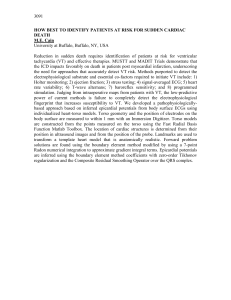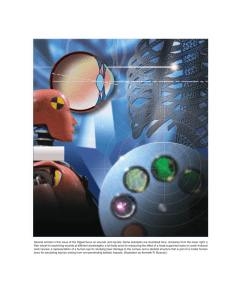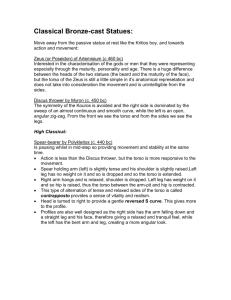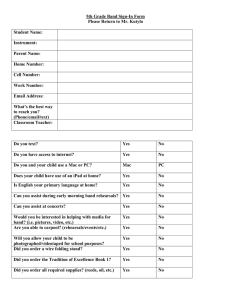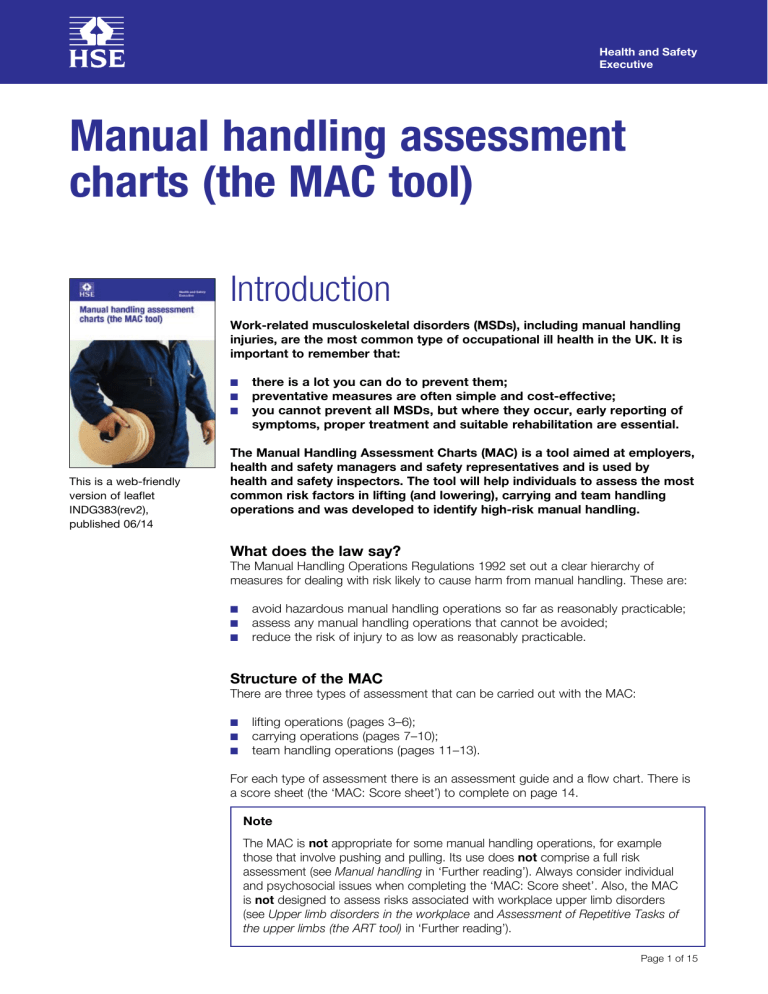
Health and Safety Executive Manual handling assessment charts (the MAC tool) Introduction Work-related musculoskeletal disorders (MSDs), including manual handling injuries, are the most common type of occupational ill health in the UK. It is important to remember that: ■■ ■■ ■■ This is a web-friendly version of leaflet INDG383(rev2), published 06/14 there is a lot you can do to prevent them; preventative measures are often simple and cost-effective; you cannot prevent all MSDs, but where they occur, early reporting of symptoms, proper treatment and suitable rehabilitation are essential. The Manual Handling Assessment Charts (MAC) is a tool aimed at employers, health and safety managers and safety representatives and is used by health and safety inspectors. The tool will help individuals to assess the most common risk factors in lifting (and lowering), carrying and team handling operations and was developed to identify high-risk manual handling. What does the law say? The Manual Handling Operations Regulations 1992 set out a clear hierarchy of measures for dealing with risk likely to cause harm from manual handling. These are: ■■ ■■ ■■ avoid hazardous manual handling operations so far as reasonably practicable; assess any manual handling operations that cannot be avoided; reduce the risk of injury to as low as reasonably practicable. Structure of the MAC There are three types of assessment that can be carried out with the MAC: ■■ ■■ ■■ lifting operations (pages 3–6); carrying operations (pages 7–10); team handling operations (pages 11–13). For each type of assessment there is an assessment guide and a flow chart. There is a score sheet (the ‘MAC: Score sheet’) to complete on page 14. Note The MAC is not appropriate for some manual handling operations, for example those that involve pushing and pulling. Its use does not comprise a full risk assessment (see Manual handling in ‘Further reading’). Always consider individual and psychosocial issues when completing the ‘MAC: Score sheet’. Also, the MAC is not designed to assess risks associated with workplace upper limb disorders (see Upper limb disorders in the workplace and Assessment of Repetitive Tasks of the upper limbs (the ART tool) in ‘Further reading’). Page 1 of 15 Health and Safety Executive How to complete a MAC assessment G = GREEN - Low level of risk Although the risk is low, consider the exposure levels for vulnerable groups such as pregnant women or young workers, where appropriate. A = AMBER - Medium level of risk Examine tasks closely. R = RED - High level of risk Prompt action needed. This may expose a significant proportion of the working population to risk of injury. P = PURPLE - Very high level of risk Such operations may represent a serious risk of injury and should come under close scrutiny, particularly when the entire weight of the load is supported by one person. ■■ ■■ ■■ ■■ ■■ ■■ Spend some time observing the task (videoing may help) to ensure that what you are seeing is representative of normal working procedures. You should involve your employees and safety representatives during the assessment process. Where several people do the same task, make sure you have some insight into the demands of the job from all employees’ perspective. Select the appropriate type of assessment (ie lifting, carrying or team handling). If a task involves lifting and carrying, consider both. Follow the appropriate assessment guide and flow chart to determine the level of risk for each risk factor. Information on risk reduction can be found on the HSE website at www.hse.gov.uk/msd and in the HSE publication Manual handling at work (see ‘Further reading’). Enter the colour band and corresponding numerical score on the ‘MAC: Score sheet’. The colour bands help determine which elements of the task require attention. Enter the remaining task information and use the scores to help identify which risk factors need to be examined and the total level of exposure to risk. If the individual does a number of tasks, assess each one separately and prioritise action to address the highest scoring task. Further guidance on using the MAC tool can be accessed online at www.hse.gov.uk/msd/mac. Remember The purpose of the assessment is to identify and then reduce the overall level of risk of the task. Manual handling assessment charts (the MAC tool) Page 2 of 15 Health and Safety Executive Assessment guide for lifting operations A Load weight/frequency Note the weight of the load and the repetition rate of the lifting operation. Take note of the risk banding from the graph below and enter the colour band and numerical score onto the ‘MAC: Score sheet’. If the colour band is purple, the task should be examined very closely, as such operations may represent a serious risk of injury and should come under close scrutiny, particularly when the entire weight of the load is supported by one person. Note: High frequency handling operations of light weights will fall within the green zone, but may be associated with upper limb problems. Please refer to Upper limb disorders in the workplace and Assessment of Repetitive Tasks of the upper limbs (the ART tool) (see ‘Further reading’) for advice on further assessment. Load weight/frequency graph for lifting operations P=10 Weight of load (kg) 50 40 50 40 R=6 30 30 A=4 20 10 20 10 G=0 0 0 One lift per day 30 minutes (2) 5 minutes (12) 2 minutes (30) 1 minute (60) 14 seconds (250) 9 seconds (400) 5 seconds (720) One lift every (lifts per hour) Manual handling assessment charts (the MAC tool) Page 3 of 15 Health and Safety Executive B Hand distance from the lower back Observe the task and examine the horizontal distance between the operative’s hands and their lower back. Always assess the ‘worst case scenario’. Use the following to guide your assessment: Close: Upper arms aligned vertically and upright torso G/0 Moderate: Upper arms angled away from body Moderate: Torso bent forward A/3 A/3 Far: Upper arms angled away from body and torso bent forward R/6 C Vertical lift region Observe the position of the operative’s hands at the start of the lift and as the lift progresses. Always assess the ‘worst case scenario’. Use the following illustrations as a guide: Above knee and/or below elbow height G/0 Below knee and/or above elbow height A/1 Floor level or below At head height or above R/3 D Torso twisting and sideways bending Observe the operative’s torso as the load is lifted. If the torso twists in relation to the hips and thighs or the operative leans to one side as the load is lifted, the colour band is amber and the numerical score is 1. If the torso both twists and bends to the side as the load is lifted the colour band is red and the numerical score is 2. Little or no torso twisting or sideways bending G/0 Torso twisting or sideways bending Torso twisting and sideways bending A/1 Manual handling assessment charts (the MAC tool) R/2 Page 4 of 15 Health and Safety Executive E Postural constraints If the movements of the operative are unhindered, the colour band is green and the numerical score is 0. If the operative adopts restricted postures during the lift because of the space available (eg a narrow gap between pallet load and hopper) or the workstation design (eg an excessively high monorail conveyor), the colour band is amber and the numerical score is 1. If the posture is severely restricted, the colour band is red and the numerical score is 3 (eg work in confined areas such as baggage holds). No postural constraints Restricted posture A/1 G/0 Severely restricted posture R/3 F Grip on the load Good grip Reasonable grip G/0 Poor grip A/1 R/2 Containers with welldesigned handles or handholds, fit for purpose Containers with poor handles or handholds Containers of poor design. Loose parts, irregular objects, bulky or difficult to handle Loose parts enabling comfortable grip Fingers to be clamped at 90 degrees under the container Non-rigid sacks or unpredictable loads Dry floor but in poor condition, worn or uneven Contaminated/wet or steep sloping floor or unstable surface or unsuitable footwear G Floor surface Dry and clean floor in good condition G/0 A/1 R/2 H Other environmental factors Observe the work environment and score if the lifting operation takes place: in extremes of temperature; with strong air movements; or in extreme lighting conditions (too dark or bright). If one of the risk factors is present score 1, if two or more of the risk factors are present score 2. No factors present One factor present G/0 Two or more factors present A/1 Manual handling assessment charts (the MAC tool) R/2 Page 5 of 15 Health and Safety Executive Lifting operation A Load weight/ frequency (see graph on p3) B Hand distance from lower back C Vertical lift region D Torso twisting and sideways bending Please insert the colour and NOTE THE COLOUR AND NUMERICAL SCORE numerical scores on the AND INSERT ON SCORE SHEET ‘MAC: Score sheet’ See graph on p3 G See graph on p3 A See graph on p3 R 50 kg or more P 0 4 6 H Other environmental factors G Moderate: upper arms angled or torso bent forward A Far: upper arms angled and torso bent forward R Above knee and/or below elbow height G Below knee and/or above elbow height A Floor level or below and/or above head height R Little or no torso twisting or sideways bending G Torso twisting or sideways bending A Torso twisting and sideways bending R 0 Floor surface 6 1 Reasonable E 1 2 Manual handling assessment charts (the MAC tool) 0 R None Postural constraints G Contaminated, wet, sloping or unstable Poor 3 2 A F Grip on the load R Dry but in poor condition or uneven Good 1 0 A One factor present Dry and in good condition G 3 0 0 Two or more factors present 10 Close: upper arms vertical/torso upright G No factors present Restricted Severely restricted 1 2 G 0 A 1 R 2 G 0 A 1 R 3 Page 6 of 15 Health and Safety Executive Assessment guide for carrying operations A Load weight/frequency Note the weight of the load and the frequency of the carrying operation. Take note of the risk banding on the graph below and enter the colour band and numerical score on the ‘MAC: Score sheet’. If the colour band is purple the task should be examined very closely, as such operations may represent a serious risk of injury and should come under close scrutiny, particularly when the entire weight of the load is carried by one person. Load weight/frequency graph for carrying operations P=10 Weight of load (kg) 50 40 50 40 R=6 30 30 A=4 20 10 20 10 G=0 0 0 One carry per day 30 minutes (2) 5 minutes (12) 2 minutes (30) 1 minute (60) 12 seconds (300) One carry every (carries per hour) B Hand distance from the lower back Observe the task and examine the horizontal distance between the operative’s hands and their lower back. Always assess the ‘worst case scenario’. Use the following illustrations to guide your assessment: Close: Upper arms aligned vertically and upright torso G/0 Moderate: Upper arms angled away from body Moderate: Torso bent forward A/3 Manual handling assessment charts (the MAC tool) A/3 Far: Upper arms angled away from body and torso bent forward R/6 Page 7 of 15 Health and Safety Executive C Asymmetrical torso/load The operative’s posture and the stability of the load are risk factors associated with musculoskeletal injury. The following illustrations should guide your assessment. Load and hands symmetrical in front of the torso G/0 Load and hands asymmetrical, upright body position A/1 One handed carrying to the individual’s side R/2 D Postural constraints If the operative’s movements are unhindered, the colour band is green and the numerical score is 0. If the operative adopts restricted postures during the carry (eg a narrow doorway making the operative turn or move the load to get through) the colour band is amber and the numerical score is 1. If the posture is severely restricted, the colour band is red and the numerical score is 3 (eg carrying loads in a forward bent posture in areas with low ceilings such as cellars). No postural constraints Restricted posture A/1 G/0 Severely restricted posture R/3 E Grip on load Good grip Reasonable grip G/0 Poor grip A/1 R/2 Containers with welldesigned handles or handholds, fit for purpose Containers with poor handles or handholds Containers of poor design. Loose parts, irregular objects, bulky or difficult to handle Loose parts enabling comfortable grip Fingers to be clamped at 90 degrees under the container Non-rigid sacks or unpredictable loads Dry floor but in poor condition, worn or uneven Contaminated/wet or steep sloping floor or unstable surface or unsuitable footwear F Floor surface Dry and clean floor in good condition G/0 A/1 R/2 G Other environmental factors Observe the work environment and score if the carrying operation takes place: in extremes of temperature; with strong air movements; or in extreme lighting conditions (dark, bright or poor contrast). If one of the risk factors is present score 1, if two or more of the risk factors are present score 2. No factors present One factor present G/0 Two or more factors present A/1 Manual handling assessment charts (the MAC tool) R/2 Page 8 of 15 Health and Safety Executive H Carry distance Observe the task and estimate the total distance that the load is carried (not the distance ‘as the crow flies’). 2 m—4 m 4 m—10 m G/0 10 m or more A/1 R/3 I Obstacles en route Observe the route. If the operator has to carry a load up a steep slope, up steps, through closed doors or around tripping hazards, the colour band is amber and the numerical score is 2. If the task involves carrying the load up ladders, enter ‘R’ (red) for the colour band and 3 for the numerical score. If the task involves more than one of the risk factors (eg a steep slope and then up ladders) total the scores on the score sheet. Enter the ladder height data and/or the angle in the task description box on the score sheet. No obstacles and carry route is flat Steep slope or up steps or through closed doors or trip hazards G/0 A/2 Manual handling assessment charts (the MAC tool) Ladders R/3 Page 9 of 15 Health and Safety Executive Please insert the colour and numerical scores on the ‘MAC: Score sheet’ Carrying operation A Load weight/ frequency (see graph on p7) B Hand distance from lower back C Asymmetrical torso/load See graph on p7 G See graph on p7 A See graph on p7 R 50 kg or more P Close: upper arms vertical/torso upright G 0 R Asymmetrical or offset load/hands D Restricted Severely restricted Good E Reasonable Poor Obstacles en route 10 Far: upper arms angled and torso bent forward Load symmetrical in front/two hands I 6 A None Grip on the load 4 Moderate: upper arms angled or torso bent forward One-handed to side or twisting/ back bent Postural constraints 0 H Carry distance 3 6 G 0 A 1 G Steep slope or up steps or through closed doors or trip hazards A G Other environmental factors 2 m—4 m G 4 m—10 m A 10 m or more R 0 A 1 R Floor surface 3 0 1 3 G 0 A One factor present 1 Dry and in good condition F 2 R Two or more factors present 2 0 Ladders No factors present R G No obstacles and carry route is flat R 2 G 0 Dry but in poor condition or uneven A Contaminated, wet, sloping or unstable R 1 2 3 G 0 A 1 R 2 Manual handling assessment charts (the MAC tool) Page 10 of 15 Health and Safety Executive Assessment guide for team handling operations A Load weight Note the weight of the load and the number of operatives performing the task. Enter the colour band and numerical score on the ‘MAC: Score sheet’. If the colour band is purple the task should be examined very closely. Such operations may represent a serious risk of injury and should come under close scrutiny, particularly when the entire weight of the load is supported by the team. 2 person<35 kg 3 person<40 kg 2 person 35—50 kg 3 person 40—75 kg 4 person 40—100 kg 2 person 50—85 kg 3 person 75—125 kg 4 person 100—170 kg R/6 A/4 G/0 2 person>85 kg 3 person>125 kg 4 person>170 kg P/10 B Hand distance from the lower back Observe the task and examine the horizontal distance between each operative’s hands and their lower back. Always assess the ‘worst case scenario’. Use the following illustrations to guide your assessment: Close: Upper arms aligned vertically and upright torso G/0 Moderate: Torso bent forward or upper arms angled away from body A/3 Far: Upper arms angled away from body and torso bent forward R/6 C Vertical lift region Observe the position of the operatives’ hands at the start of the lift and as the lift progresses. Always assess the ‘worst case scenario’. Use the following illustrations as a guide: Above knee and/or below elbow height G/0 Below knee and/or above elbow height Manual handling assessment charts (the MAC tool) A/1 At head height or above, or floor level or below R/3 Page 11 of 15 Health and Safety Executive D Torso twisting and sideways bending Observe the operatives’ torsos as they lift the load. If the torso twists in relation to the hips and thighs or if the operatives lean to one side as the load is lifted, the colour band is amber and the numerical score is 1. If the torso both twists and bends to the side as the load is lifted, the colour band is red and the numerical score is 2. Little or no torso twisting or sideways bending Torso twisting or sideways bending G/0 Torso twisting and sideways bending A/1 R/2 E Postural constraints If the movements of the operatives are unhindered, the colour band is green and the numerical score is 0. If the operatives adopt restricted postures during the lift because of the space available (eg narrow space between team members) or the workstation design (eg an excessively high monorail conveyor), the colour band is amber and the numerical score is 1. If the postures are severely restricted, the colour band is red and the numerical score is 3 (eg work in confined areas such as baggage holds). No postural constraints Restricted posture A/1 G/0 Severely restricted posture R/3 F Grip on load Good grip Reasonable grip G/0 Poor grip A/1 R/2 Containers with welldesigned handles or handholds, fit for purpose Containers with poor handles or handholds Containers of poor design. Loose parts, irregular objects, bulky or difficult to handle Loose parts enabling comfortable grip Fingers to be clamped at 90 degrees under the container Non-rigid sacks or unpredictable loads Dry floor but in poor condition, worn or uneven Contaminated/wet or steep sloping floor or unstable surface or unsuitable footwear G Floor surface Dry and clean floor in good condition G/0 A/1 R/2 H Other environmental factors Observe the work environment and score if the lifting operation takes place: in extremes of temperature; with strong air movements; or in extreme lighting conditions (dark, bright or poor contrast). If one of the risk factors is present score 1, if two or more of the risk factors are present score 2. No factors present One factor present G/0 Two or more factors present A/1 R/2 I Communication, co-ordination and control Communication between the operatives is essential when lifting as part of a team. Examples of good communication would be that you may hear the operatives counting ‘one, two, three’ etc before the lift. Look to see if the team have control of the load, that it is lifted smoothly, and that all members lift together. An unco-ordinated team lift may leave one member of the team bearing the entire weight. Good G/0 Reasonable A/1 Manual handling assessment charts (the MAC tool) Poor R/3 Page 12 of 15 Health and Safety Executive Please insert the colour and numerical scores on the ‘MAC: Score sheet’ Team handling operation A Load weight B Hand distance from lower back C Vertical lift region D Torso twisting and sideways bending 2 person < 35 kg 3 person < 40 kg G 2 person 35—50 kg 3 person 40—75 kg 4 person 40—100 kg A 2 person 50—85 kg 3 person 75—125 kg 4 person 100—170 kg R 2 person >85 kg 3 person >125 kg 4 person >170 kg P Close: upper arms vertical/torso upright G Moderate: upper arms angled or torso bent forward A Far: upper arms angled and torso bent forward R 4 6 3 Below knee and/or above elbow height A Floor level or below and/or above head height R A Torso twisting and sideways bending R Restricted Severely restricted R 3 G 0 A One factor present 1 Dry and in good condition G Floor surface 0 1 Grip on the load 2 G 0 A Contaminated, wet, sloping or unstable R GOOD Good F R Dry but in poor condition or uneven 3 Torso twisting or sideways bending 1 Two or more factors present 1 G A REASONABLE Reasonable No factors present Other environmental factors 0 Little or no torso twisting or sideways bending 0 Poor 6 G E I Communication, co-ordination and control H 0 G Good 10 Above knee and/or below elbow height None Postural constraints 0 Reasonable Poor 1 2 G 0 A 1 R 2 2 G 0 A 1 R 3 Manual handling assessment charts (the MAC tool) Page 13 of 15 Good Manual handling assessment charts (the MAC tool) Signature: ______________________________________________________________________ Date: ______________________________________________________________________________ Other indications, if so, what? __________________________________________________ Employees doing the work show signs that they are finding it hard work (eg breathing heavily, red-faced, sweating). Task is known to be hard work or high risk. Task has a history of manual handling incidents (eg company accident book, RIDDOR reports). Are there indications that the task is high risk? (Tick the appropriate boxes) Task description: Company name:_________________________________________________________________ MAC: Score sheet Carry Total score: Lift Team Colour band (G, A, R or P) Lift Carry Team Numerical score Other risk factors: Record individual and psychosocial factors etc (see website – address on page 15) Communication and co-ordination (team handling only) Obstacles en route (carrying only) Carry distance Other environmental factors Floor surface Grip on the load Postural constraints Torso twisting/sideways bending Asymmetrical torso/load (carrying) Vertical lift region Hand distance from the lower back Load weight and lift/carry frequency Risk factors Insert the colour band and numerical score for each of the risk factors in the boxes below, referring to your assessment, using the tool. Health and Safety Executive Page 14 of 15 Health and Safety Executive Further reading Assessment of Repetitive Tasks of the upper limbs (the ART tool): Guidance for health and safety practitioners, consultants, ergonomists and large organisations Leaflet INDG438 HSE Books 2010 www.hse.gov.uk/pubns/indg438.pdf Managing upper limb disorders in your business: A brief guide for employers Leaflet INDG171(rev2) HSE Books 2013 www.hse.gov.uk/pubns/indg171.htm Manual handling at work. A brief guide Leaflet INDG143(rev3) HSE Books 2012 www.hse.gov.uk/pubns/indg143.htm Manual handling. Manual Handling Operations Regulations 1992 (as amended). Guidance on Regulations L23 (Third edition) HSE Books 2004 ISBN 978 0 7176 2823 0 www.hse.gov.uk/pubns/books/l23.htm Upper limb disorders in the workplace HSG60 (Second edition) HSE Books 2002 ISBN 0 978 0 7176 1978 8 www.hse.gov.uk/pubns/books/hsg60.htm Further guidance on using the MAC tool can be accessed online at www.hse.gov.uk/msd/mac. Further information For information about health and safety, or to report inconsistencies or inaccuracies in this guidance, visit www.hse.gov.uk. You can view HSE guidance online and order priced publications from the website. HSE priced publications are also available from bookshops. This guidance is issued by the Health and Safety Executive. Following the guidance is not compulsory, unless specifically stated, and you are free to take other action. But if you do follow the guidance you will normally be doing enough to comply with the law. Health and safety inspectors seek to secure compliance with the law and may refer to this guidance. This leaflet is available at: www.hse.gov.uk/pubns/indg383.htm. © Crown copyright If you wish to reuse this information visit www.hse.gov.uk/ copyright.htm for details. First published 06/14. Published by the Health and Safety Executive 06/14 INDG383(rev2) Page 15 of 15
